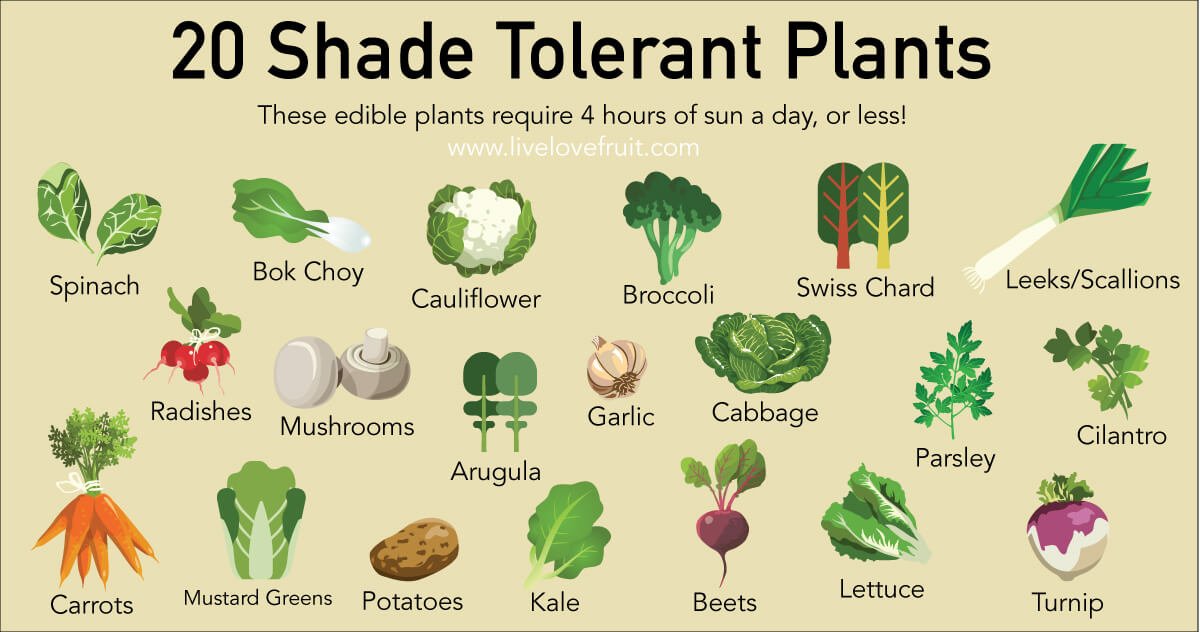
With a rise in people wanting to become more sustainable, finding places to grow things can be tricky. That’s why you’re going to be shocked to discover that there are over 20 shade tolerant plants that you can grow in areas of the garden that you normally thought couldn’t be utilized.
These edible shade-tolerant plants include things like root vegetables, leafy greens, herbs, and mushrooms! They all need just 4-6 hours of sun a day, or less!
Understanding Sun Exposure
All plants require sunlight to grow, but some plants don’t need as much as others. Tomatoes, for example, require full sunlight during the day, meaning they shouldn’t be planted in an area that only receives sun for half a day.
Most labels found on plants, or even seed packets will let you know how much sun a plant needs to grow. You’ll often find these described as follows:
- Full sun: plants that need at least 6 hours of direct sunlight between the hours of 10 am and 6 pm. In northern climates where the sun is weaker, plants may require up to 8 hours of sunlight each day.
- Part sun: plants that thrive with only 3-6 hours of direct sunlight every day between the hours of 10 am and 6 pm. In northern climates where the sun is weaker, plants may require up to 5-8 hours of sunlight each day.
- Part shade: plants that need around 3-6 hours of sun per day, but need protection from the intense mid-day sun. These plants do well when they receive filtered or dappled sunlight all day. Dappled means that light gets filtered through another plant, such as the leaves of a tree.
- Full shade: plants that require less than 3 hours of direct sunlight per day. Some descriptions claim that full shade means complete darkness – for the purposes of this article, I am using the description as less than 3 hours of direct sunlight. This could mean an east-facing side of the house could have a garden along its edge, as long as you planted full shade-tolerant plants.
Planning your Garden
Planning your garden before you actually plant is it the best way to ensure you get decent crop yields.
Creating microclimates – small areas of your garden that have different climates from the area around it – is a great way to suit the needs of specific crops that may otherwise struggle without your help.
A section of your yard that is partially shaded will be different than an area that receives full shade or full sun. Partially shaded areas may be a great area to extend crops that may otherwise go to bolt and turn bitter in direct sun, and as temperatures rise (like leafy greens).
Planting your fall garden under the dappled sunlight provided by the trees in summer will provide them with extra sunlight in the fall when the leaves shed. Cooler temperatures and extra sunshine might just be enough to enhance growth for your autumn crop.
When planting a garden, it is also important to think about companion planting, which is the planting of different crops in proximity to naturally control pests, improve pollination, maximize the use of space and increase crop productivity.
20 Shade-Tolerant Plants
Without further adieu, here is a list of shade-tolerant plants that grow well in most of North America!
1. Spinach
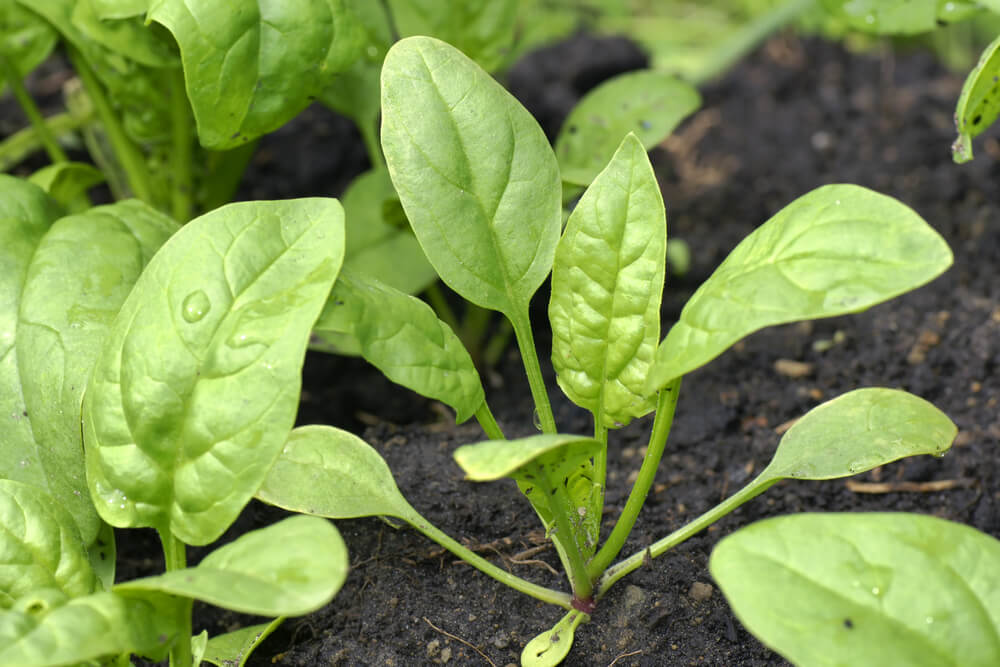
Almost all lettuce plants prefer less sun, and that includes spinach, too! Plant them in cooler, shadier areas of your garden, aiming for around 3-4 hours of sun per day.
Spinach is an early bolter and is best grown both early and late in the season. The heat of mid-summer often makes the leaves too bitter and goes to bolt quite quickly.
2. Bok Choy

Asian greens like bok choy, tatsoi, and komatsuna will grow very well with just a couple hours of sun per day. Plus, they taste incredible and add a beautiful twist on any salad.
Bok choy can actually be planted in late summer as other areas of the garden become freed up. They are frost-hardy, so they continue to grow after cold weather hits.
Planting it in areas that don’t receive full sun is wise, as this plant is prone to bolting in the hot summer sun. Alternatively, you could plant bok choy early spring/summer, and again towards the end of summer when temperatures are generally cooler.
3. Broccoli

Too much sun on your broccoli will make it flower at a much faster rate, which can spoil the taste. These plants do not tolerate full, direct sun very well.
Partial sun (around 4 and no more than 6 hours per day) will allow the heads to remain tight and will slow flowering.
Broccoli prefers cool weather and will tolerate temperatures as low as 20 degrees Fahrenheit. It is actually one of the few vegetables that grow well in partial shade.
You can technically plant broccoli in full sun, but you would have to time your planting well so that the heads don’t mature until later in summer once the heat has died down a bit.
4. Cauliflower

Similar to broccoli, too much sun will make this cruciferous veggie not taste the greatest. Limiting sunlight to under 6 hours per day will ensure tighter heads and better flavor.
Cauliflower craves cooler weather and will grow well in partial shade. Planting in full sun is possible, but you risk having the plant bolting before you have the chance to harvest any edible matter. If you do choose to plant full-sun, make sure you time it so that the plant matures once the heat of the summer has passed.
5. Swiss Chard

This leafy green doesn’t enjoy a lot of sunlight, like most leafy greens. It is a bit more tolerant of heat than other leafy greens (like spinach), but when planted in direct light, the plant may bolt, turn bitter and become inedible.
If you have a partially shaded area of the garden, swiss chard will grow quite well. Be sure to plant them in an area that receives less than 4 hours of sunlight per day.
If you live in a Northern climate, sow from early spring to midsummer for a fall crop; in the South sow in fall to spring.
6. Leeks/Scallions
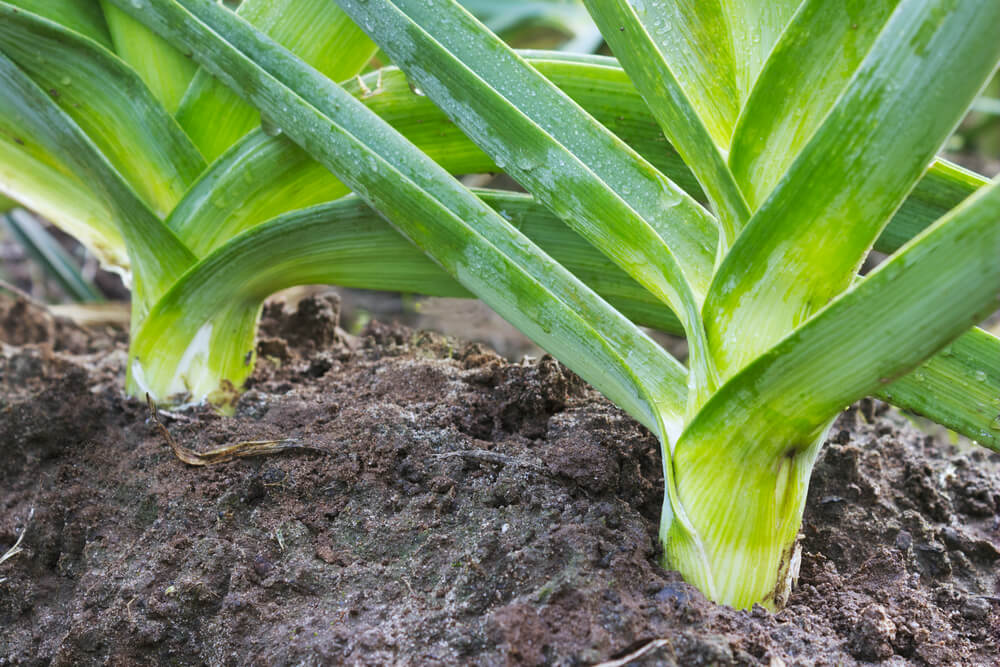
Leeks thrive in cooler, moist environments. Plots that get morning sun and afternoon shade are a great area to grow leeks. They need some sun, but not a lot.
Planting in partial shade will get that pure white stalk to pop up much faster than when planted in full sun. The white stalk must be shielded from the sun so that it blanches.
The ideal temperature for leeks is around 60 degrees Fahrenheit. They can even tolerate light frost. You never want the plant to freeze, however, so make sure to cover if you anticipate heavy frost.
7. Radishes
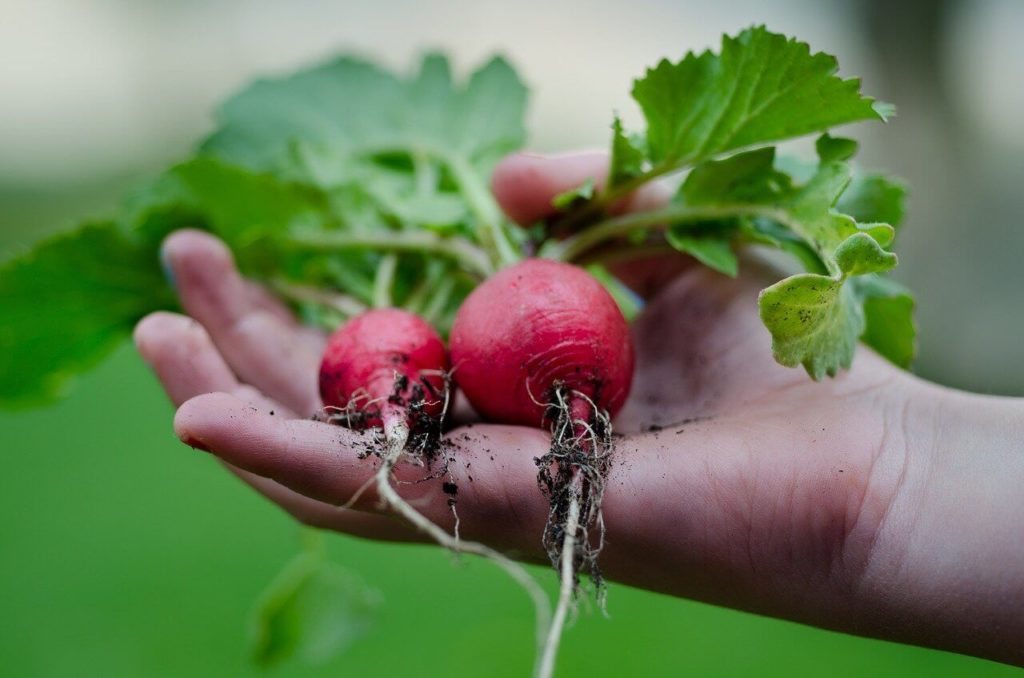
Radishes, like most root plants, need more root growth and less foliage growth to ensure larger harvest and tastier produce. Too much sun will provide larger foliage and less root, which is counterproductive because the root is the part you eat!
While radishes do require around 4-6 hours of full sun per day, they are tolerant of some shade. Radishes prefer cooler weather, so shady areas could very well satisfy their growing needs.
Planting in a shaded area might mean that you could have radishes on hand all summer long. As they’re not very tolerant of mid-summer heat, planting them in the shade would give them the cooler temperatures they need to thrive.
8. Mushrooms

Most people already know this about mushrooms, but they don’t like a lot of sunlight. Mushroom growing is an art in and of itself, and they really prefer dark, cooler, moist areas to grow!
Making mushroom beds to grow your own mushrooms outdoors is easy, and doesn’t require any special tools or technology.
You will need to purchase some mushroom spores online first, and then get your medium ready. You can usually grow mushrooms in a patch of straw or surrounded by peat moss.
Mushrooms thrive in cool dark places, so the shadiest parts of your garden that receive almost no sun during the day would be the perfect place to grow.
Some varieties of mushrooms like Oyster mushrooms only need a simple sprinkle on the soil to get growing in just a few weeks!
9. Arugula
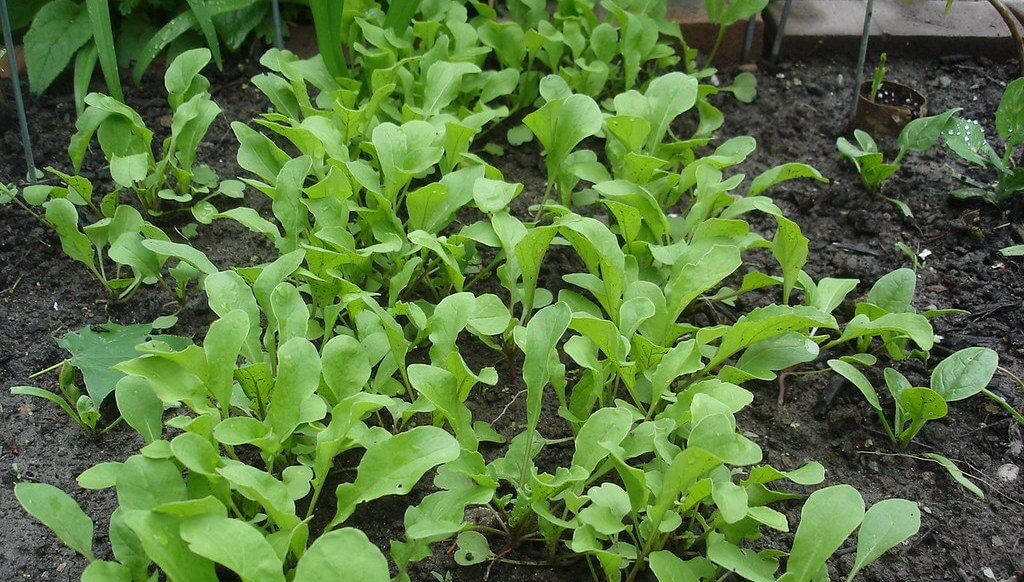
Another shade-tolerant plant, arugula, thrives in areas that are less sunny. Too much sun will droop and shrivel the leaves, and who wants a limp salad?
Choose an area of the garden that receives morning sun, but doesn’t receive as much sun later in the afternoon. This will prevent bolting and bitterness.
Arugula can also be planted underneath other larger plants that require the sun to grow.
What I love about arugula is that it sprouts very quickly, so you can have a salad in under a few weeks. Sowing new seeds continuously every 2-3 weeks will ensure you have enough arugula to last you an entire growing season!
10. Garlic
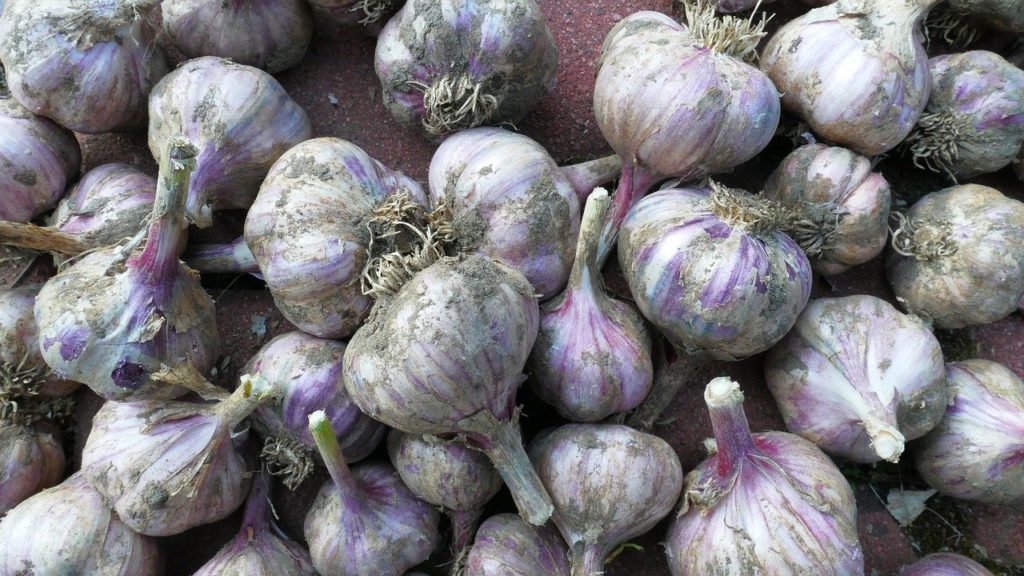
Garlic will mature with just under 4 hours of sunlight per day. For large bulbs, garlic is suggested to be planted in full sun, but the plant will also mature in partial shade.
Plant garlic as soon as the ground can be worked in early spring. You will have to buy ‘seed garlic’ at a nursery, or you can plant gloves of organic garlic from the grocery store that have gone to sprout.
If you do plant in a partially shaded area, do not water excessively, as the cloves may rot. Shaded areas don’t need to be watered as vigorously, as the soil doesn’t dry out as fast.
As your garlic starts to mature in early fall, you can plant a second crop for harvest the following spring.
11. Cabbage
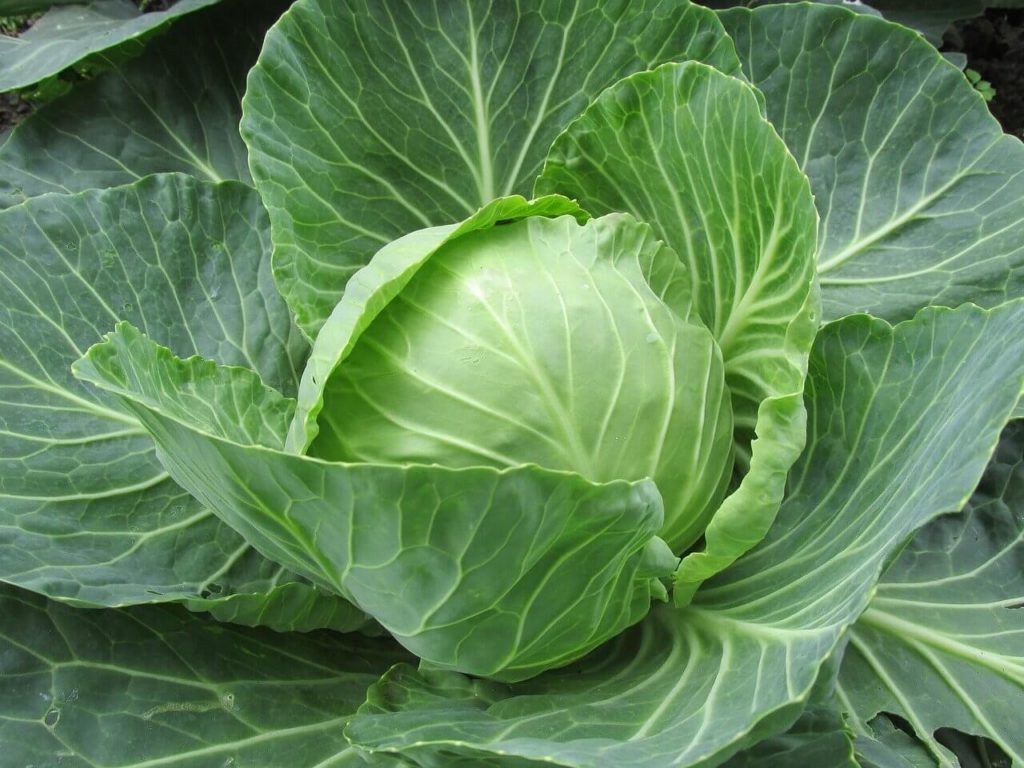
Cabbage can be grown in full sun or partial sun. When grown in full sun, there is a bigger risk of pests who thrive in full heat. This is why I would suggest planting cabbage in partial sun.
While more sun will ensure your cabbage remains tight and compact, I have had much success growing my own cabbages in partial sun (with heads that were tight and compact).
If you plant cabbage in early spring, sow seeds in the soil directly. I usually start my seeds indoors and then slowly acclimate the sprouts to the outdoor elements before transplanting. Always transplant on a cloudy, cool day to prevent transplant shock.
12. Parsley
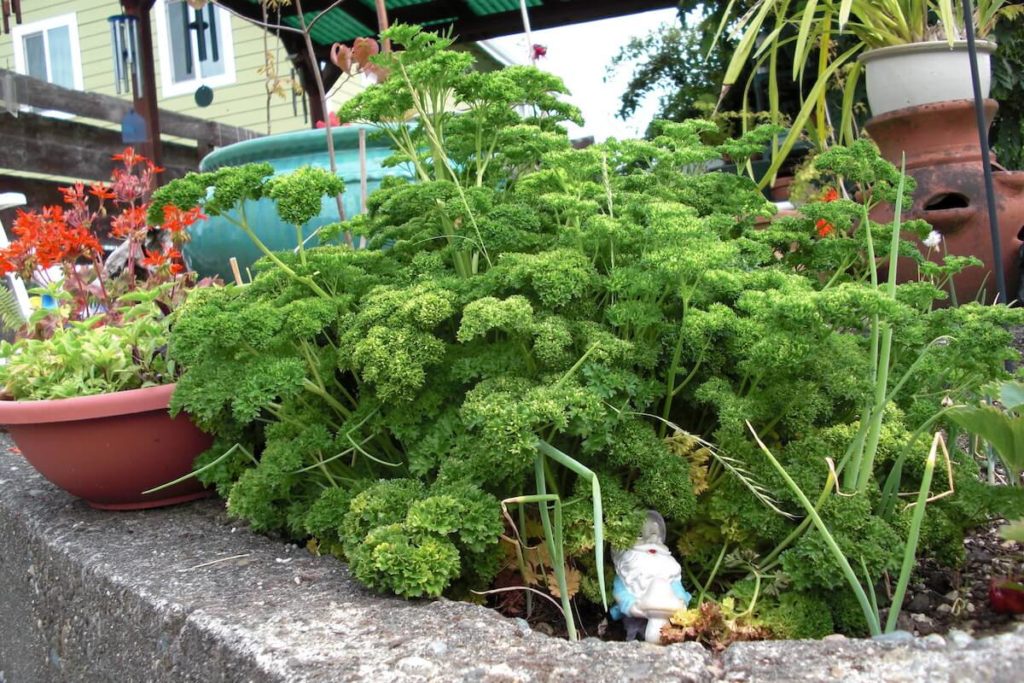
All herbs are fond of shaded areas. Parsley will produce leaves that are bigger and more flavourful if you keep it in an area that receives little sunlight.
Parsley is cold hardy, and can even be harvested for much of winter! I’ve personally done this myself. It is very frost-tolerant.
For these reasons, parsley is also great at growing places where sunshine is slim. In hot, humid climates, growing in the shade is especially important. In fact, in temperatures above 90 degrees Fahrenheit, parsley plants can die.
I always grow my parsley in areas that only get around 3 hours of sunlight per day, and it thrives. The flavor is also incredible. Nothing like fresh grown parsley.
13. Cilantro

Cilantro, or coriander, like most herbs, prefer less sunlight. It will help keep the plant smaller, and larger-leafed, which means a bigger harvest and more flavor.
If planted in direct sun, cilantro will be quick to bolt, especially as you near closer to mid-summer. If you want cilantro all summer long, you can plant it in areas that get partial sun, or plant early spring in full sun, and late summer in full sun.
Another tip: cilantro likes well-drained, moist soil. Soil that is on the sandy side will work well for cilantro. Combined with a little mulching, you’ll create the perfect microenvironment for this herb to thrive.
14. Carrots

Carrots love the shade – allowing them to grow with under 4 hours of sun per day will encourage more root growth and less foliage growth (which, when planted in full sun, will encourage the opposite).
As a cool-season vegetable, carrots prefer temperatures of 60 to 65 degrees Fahrenheit. This makes partially-shaded areas of the garden a great place to grow carrots.
15. Mustard Greens

Mustard greens will grow well in the sun or partial shade. They prefer cooler weather and will bolt in direct sunlight.
If you’re planting in partial shade, you don’t have to plan how or when you’ll grow your mustard greens. However, if you want to plant in areas with direct sun, you’ll want to grow an early spring crop, and then plant a later crop towards the end of summer to avoid the harsh mid-summer heat.
16. Potatoes
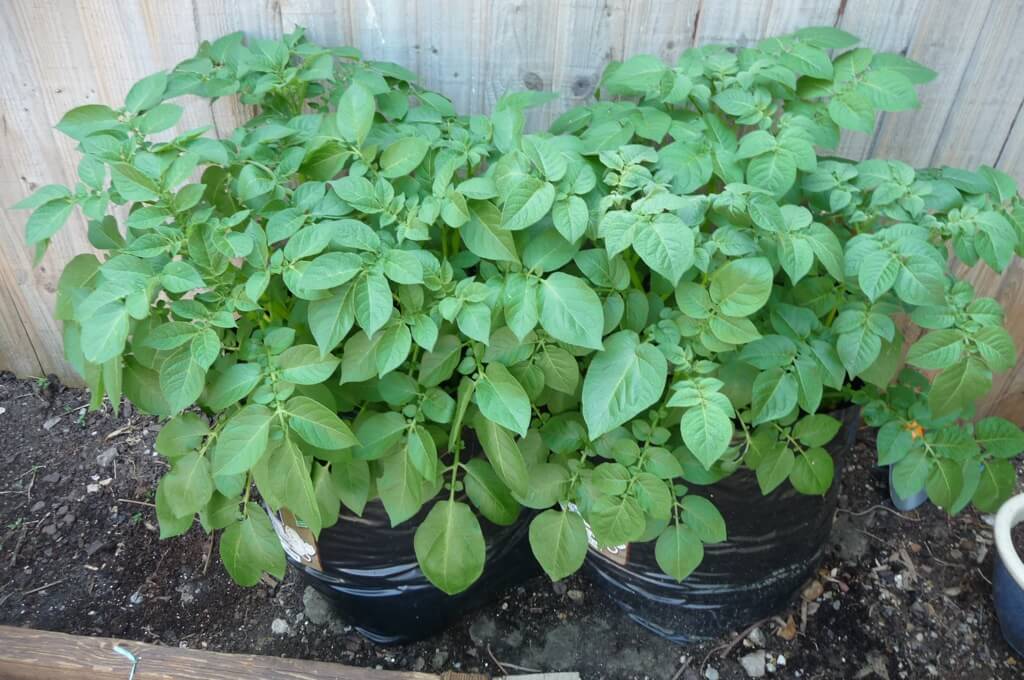
Who doesn’t love fresh garden potatoes? Potatoes do well in full sun or partial shade. If grown in partial shade, they might take a little longer to mature, but if you have the space (and the shade), then why not make use of the space by growing more edible plants?
If you don’t want to wait for your potatoes to mature, you could always harvest when they are younger. You know those baby potatoes you see in stores? That’s what I’m talking about!
Planting in the shade will also prevent sunburn on potatoes, which causes them to turn green and produce a toxin called solanine. This toxin can make you very ill, and if eaten in large quantities, may even be fatal.
17. Kale

Just like cabbage, its close cousin, kale doesn’t like a lot of sun. It prefers cold weather and less sunlight!
I always grow successful kale, collard, and cabbage patches along the east side of my house, which only receives morning sun. The plants grow absolutely massive and thrive.
My favorite thing about kale is that it is very cold-hardy. You can harvest kale well into the winter months, even after it has snowed.
The cooler the temperatures are, the sweeter the kale will become, too. Leaving your kale until after the first frost will make it taste considerably sweeter.
18. Beets
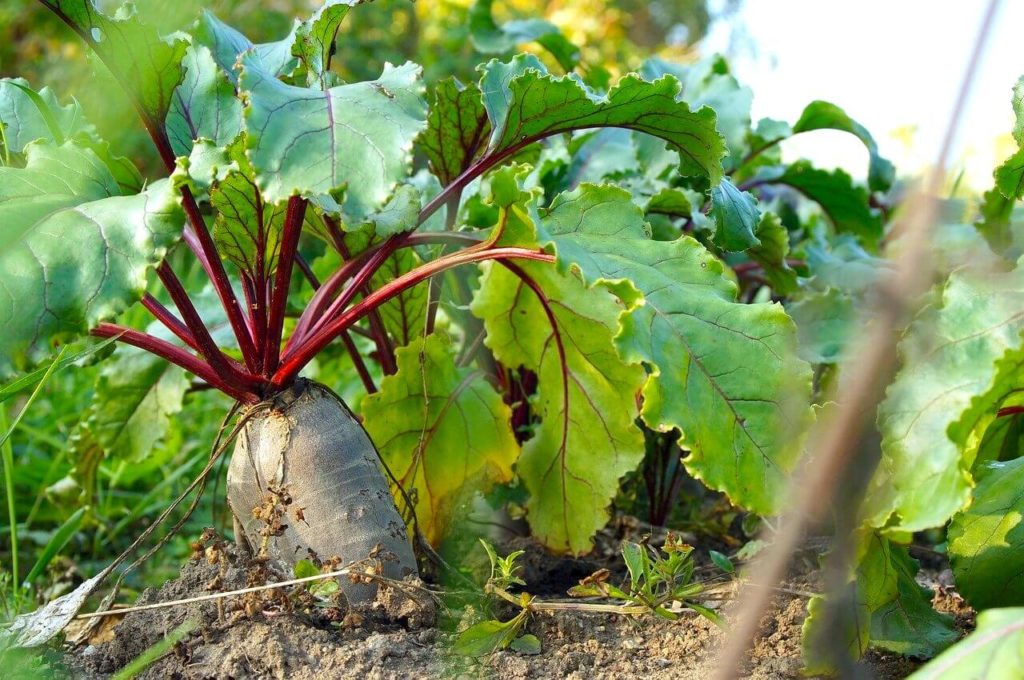
Beets should not be grown in full shade. They need at least a half-day of full sun or partial shade throughout the day.
If beets are grown in partial shade, their greens will be more abundant, with smaller roots. But who doesn’t love baby beets? They’re sweeter, tender, and are great when roasted.
Beet greens are incredibly nutritious, too, and can be chopped up and added to salads, or to fresh pots of borscht.
19. Lettuce
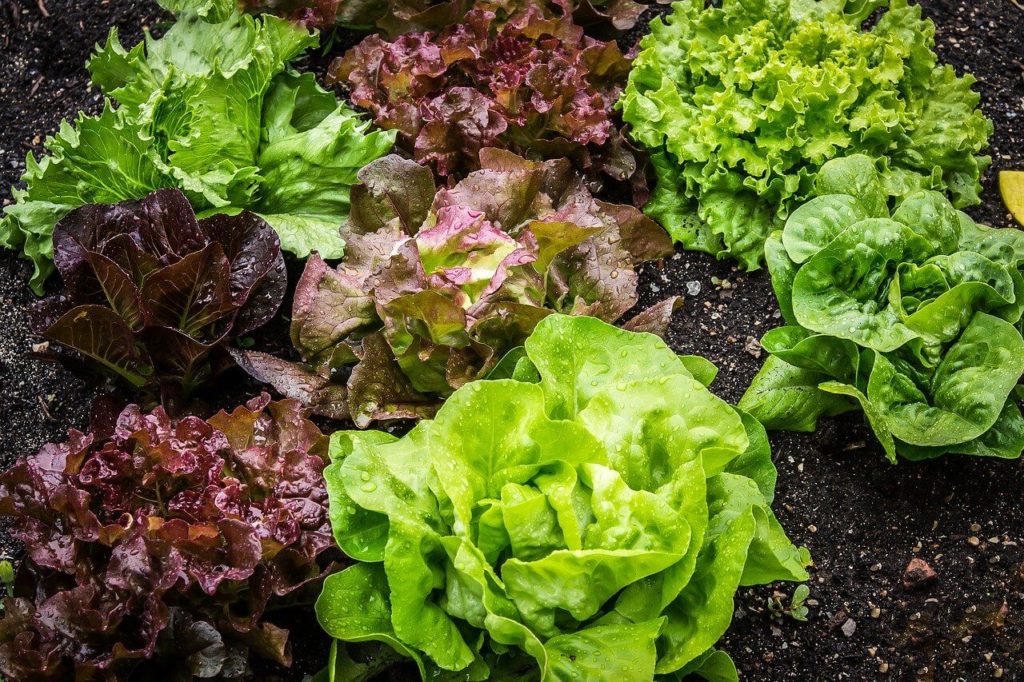
Almost all leaf lettuce prefers less sun during the day. As lettuce tends to bolt when the heat comes on, it is always best to plant in an area that is out of direct sunlight during the heat of the day.
The cool thing about lettuce is that if you simply cut away what you need instead of ripping up the whole plant, new leaves will sprout up from where you once cut. This means that you don’t need to replant your greens, and can instead harvest all summer long.
20. Turnips
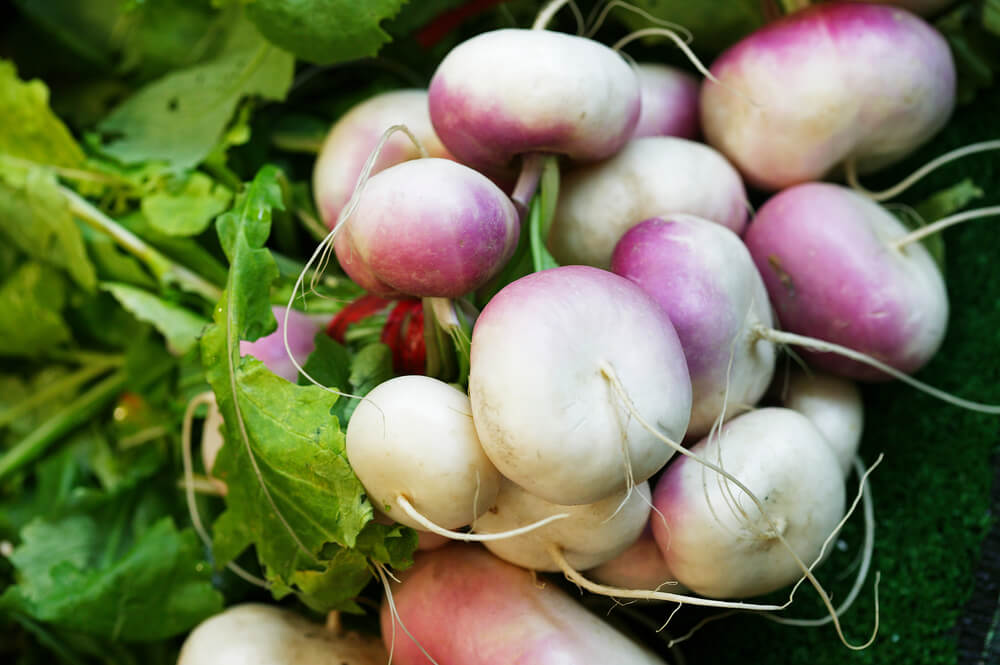
Turnips can be grown in full sun or partial shade. They can get by on as little as 4-5 hours of sunlight per day. Keep in mind that if they receive less sunlight, then they will grow a bit slower and take a bit longer to mature and reach full size.
You can harvest turnips before they reach full size, too! Just like harvesting baby potatoes, carrots, and beets, baby turnips can also be harvested while they are still small and sweet.
You can also harvest turnip greens while you’re waiting for their roots to fill out. They’re highly nutritious and can be added to salads, soups, and stews.
Tips for Growing in The Shade
As with any gardening, what you put into the soil will provide you with what you get out of it. If your soil is stripped dry (aka. no mulching), the number of nutrients in the food you’re eating will be greatly reduced.
So my first suggestion to anyone starting a garden, or to those who want to maximize yield and flavor of their crop: start mulching!
- Mulch: using an organic straw to cover your soil has multiple benefits. First, it helps reduce the number of weeds, as weeds can’t grow with no access to sunlight. Second, mulching helps retain moisture, so you don’t spend exorbitant amounts of money watering in the dry season. Third, mulching reduces soil erosion and ensures your produce (like leafy greens) don’t get splashed by soil during watering (so less clean-up time when you want to eat your produce!). Mulching also maintains soil nutrients, controls pests, and encourages earthworms to move it.
- Compost: if you have a compost – put it to good use! All those nutrients could be feeding your plants instead of sitting around. Adding compost to your garden is a great way to increase crop yield, as well as boost the flavor of many plants.
- Use Good Soil: using good soil, especially in areas that don’t receive much sunlight, is a great way to ensure the growing success of your plants. Opt for organic soils or nutrient-dense soils like Sea Soil.
- Maturation Times: vegetables that prefer more sunlight but are able to grow in the shade might grow slower. These plants might take a bit longer to mature than what is stated on the plant label or seed package. Don’t be discouraged, though! They will still mature, just at a slower speed.
The Bottom Line
Growing a garden can be rewarding, especially when you make use of spaces that you previously thought wouldn’t be worth it. The truth is, many plants can grow in partial to full shade, you just need to plan out your garden ahead of time to get a good idea of where everything will be going.
Keeping in mind companion planting, mulching, composting and utilizing good soil will all ensure your shade-tolerant plants grow to their full expression for you to enjoy at the time of harvest.


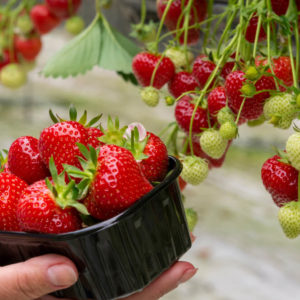
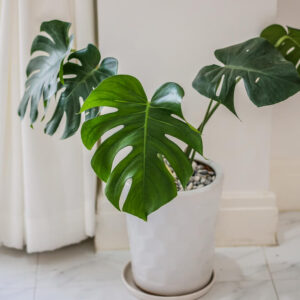
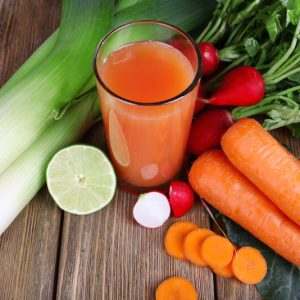

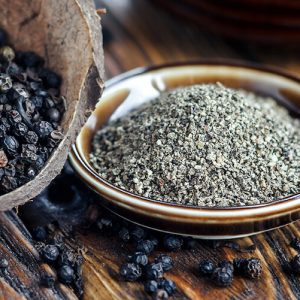
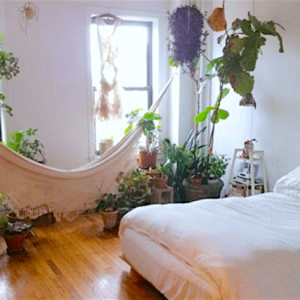
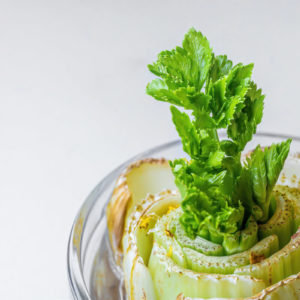
Where can I get either seeds or plants this year?
Any local nursery or online store should have seeds. Plants you would only be able to get at nurseries!
Your information on garlic is incorrect. plant garlic in full sun in the fall. if you plant in shade in the spring you will get tiny corms in the fall that are pretty useless for anything but replanting in the fall in a spot with full sun.
Leeks also love full sun as do carrots, turnips and several other crops you name here.
Hey Lucy – I’ve had success with the opposite. I’m not saying these plants also cannot be planted in full sun. What I’m saying is that they are shade-tolerant, so if you do happen to have spots that are partially-shaded and not being used, then planting these items in those areas will also prove successful.
Thank you for enlightening me